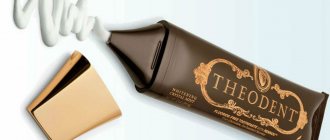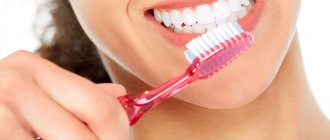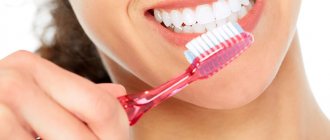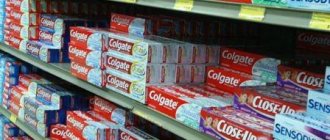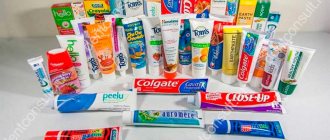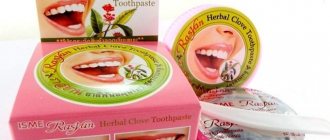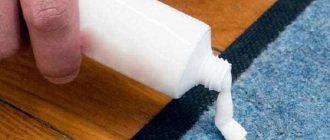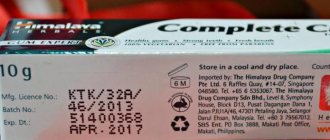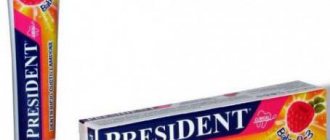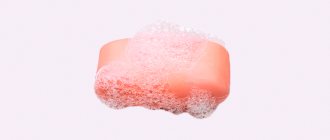Toothpaste is a mandatory attribute of personal hygiene and it is difficult to imagine a modern person who can do without oral care for a long time. Toothpaste not only eliminates bad breath, but is also a good preventive measure for quite serious diseases of the teeth and gums. However, there may be situations when toothpaste may not be at hand, or its use for some reason is not advisable. In such situations, the question is quite natural: what can replace toothpaste ? The alternative option should be as safe as possible and at the same time quite effective. In order to decide what to replace toothpaste with , you need to pay attention to its composition.
Alternative to a toothbrush
In a situation where you don’t have a brush at hand, you should use natural material. We are talking about a branch of a coniferous tree, be it pine, spruce or fir. It is enough to tear off a small stalk and place it in hot water. The tip of this product is softened by lightly chewing with your teeth. The end result is something like a brush. The product is carefully passed over the surface of the teeth, removing accumulated plaque.
Separately chew pine needles, which are rich in vitamin C, vegetable oils, and amino acids. In combination, the noted substances have a disinfecting and anti-inflammatory effect on the tissues of the oral cavity. Chewing pine needles for several minutes strengthens tooth enamel and gums.
Using a softened pine twig, it is important to thoroughly clean not only the internal, but also the external surfaces of the enamel. Particular attention should be paid to the bases of the molars. After all, it is here that the salivary ducts are located and the formation of tartar is most often observed.
Myth 7. A brush with stiff bristles is the most effective.
Tamara Terekhova recommends buying toothbrushes with soft or medium hardness. Hard ones can only be used by patients with increased formation of pigmented plaque, who also have excellent enamel stability, strong gums, and single fillings. For others, it will injure the oral mucosa and contribute to the abrasion of enamel.
If you have problems cleaning interdental spaces and hard-to-reach places, preference should be given to brushes with milled tips. They easily penetrate into all areas of the tooth and do not injure the gums.
Soda
How to brush your teeth if you don't have toothpaste? A good option is using baking soda. The substance has a non-toxic composition. The powder has an abrasive structure, which promotes high-quality plaque removal. The product has disinfecting properties. In addition to removing bacterial waste products, baking soda is a good teeth whitener.
To brush your teeth without toothpaste, dip a toothbrush or a piece of sterile cotton wool in baking soda. The substance is treated with chewing surfaces. To enhance the positive effect, you can add a couple of drops of lemon juice to the powder. At the end of the procedure, the oral cavity is thoroughly rinsed with water.
After brushing your teeth with baking soda, it is important to avoid eating food and hot drinks for an hour. The abrasive can leave microscopic damage on the enamel. Various types of influences can provoke cracking of the tooth surface in the future.
Doctors do not recommend regularly brushing and whitening your teeth with baking soda. The reason is the same scratching of the enamel by powder crystals. Particles of the substance remaining in the oral cavity can provoke inflammation of the gums and mucous membranes.
Myth 2. For good hygiene you need a lot of toothpaste
If you are a generous soul and squeeze the paste out the entire length of the brush, as it is positioned in commercials, the manufacturer will be very happy - you will run out of paste faster and you will go buy a new tube. However, according to Professor Terekhova, in order for toothpaste to fulfill its therapeutic and preventive purpose, very little of it is needed. Hold the tube with the opening facing up, press lightly to release a little paste, and use a brush moistened with water to pass over it once. Whatever lingers on the stubble is enough.
Moreover, an excess of foaming agents and other toothpaste additives can provoke a gag reflex in sensitive people and children, as well as other uncomfortable sensations that can lead to the development of an aversion to brushing teeth.
Tea tree oil
People who want to know how to brush their teeth if they don’t have toothpaste should use tea tree oil. The product contains a lot of biologically active elements that inhibit the activity of pathogenic bacteria that parasitize tooth enamel. The product has a pleasant aroma, eliminating bad odors.
The hygiene procedure is carried out according to the following scheme:
- prepare a glass of warm boiled water;
- add about 3-4 drops of tea tree oil to the liquid;
- the composition moisturizes the toothbrush and removes plaque from the enamel;
- Finally, rinse the mouth with the product several times.
It is useful to perform the procedure daily, before going to bed. Regular use of tea tree oil for oral care reduces the likelihood of developing inflammatory processes in the structure of gum tissue. The folk remedy is suitable for combating caries and periodontal disease.
Myth 3. All family members can use the same toothpaste
Often the name of the paste emphasizes its versatility. But this, according to the professor of dentistry, is just a thoughtful move by the manufacturer. There are no funds that would be suitable for an adult, a child, or a pensioner. “Common” in toothpaste is acceptable if all family members are of working age and they have the same oral problem, for example, bleeding gums or pigmented plaque on the teeth.
Children should buy pasta strictly according to age - 3+, 7+, 16+. This is primarily due to different concentrations of fluorides, which are beneficial for teeth, but can be toxic in excess. Compared to “adult” toothpaste, the fluoride content in toothpaste for preschoolers should be 3 times less (up to 500 ppm). A self-respecting manufacturer indicates these values on the box or tube of paste in the “composition” section. If there is no such information, there is reason to doubt the quality of the product.
A child who regularly uses “adult” toothpaste can become poisoned, especially if accidentally swallowed. In addition, pastes intended for adults contain abrasives and antiseptics, which are also harmful to children.
Wood ash
What can you use to brush your teeth instead of toothpaste? An ancient folk method is the use of ash. In nature, cooled coals should be taken from the fire. The substance is ground into powder. Add a couple of drops of water until a thick, paste-like consistency is formed. The product is applied to the finger and passed over the surfaces of the teeth. Finally, rinse your mouth with plenty of water. As a result, the enamel gets rid of accumulated plaque and becomes clean and snow-white.
Wood ash is more than just an abrasive. The product contains potassium, calcium, phosphorus, manganese, iron. The complex of these elements creates a special environment in the oral cavity that is not suitable for the active reproduction of pathogenic microorganisms. If you add ground mint leaves to a paste prepared from ash, you can get a product with a pleasant taste and aroma.
What can you replace toothpaste with: conclusion
Having considered all of the above methods for replacing toothpaste, we can come to the conclusion that it is advisable to combine most of them, and some (salt, soda, charcoal, etc.) are not suitable for long-term use due to their powerful abrasive properties. One of the most effective and safe alternatives can be considered an irrigator and herbal mixtures.
In the question “ what to replace toothpaste with ,” all the methods indicated can be suitable, subject to the rules of use and the absence of abuse. We also recommend that you read our article: how often should you change your toothbrush, as well as the article on how to brush your teeth correctly:.
Clay
What to do if you don't have toothpaste? How to brush your teeth? A good idea would be to use white or blue clay powder. The product is absolutely harmless to the body. The substance contains an abundance of microelements that disinfect oral tissues. Brushing your teeth with clay helps eliminate bad odor.
To rid the enamel of plaque, freshen breath and achieve a whitening effect, I act according to the following principle:
- take about 50-70 grams of white or blue clay;
- the product is moistened with a few drops of water;
- the product is mixed until a mass of paste-like consistency is formed;
- add a dessert spoon of liquid honey, as well as a couple of drops of propolis infusion, essential oils of sage and chamomile.
The prepared paste is applied to a damp brush. Brush your teeth, carefully treating the enamel surfaces. Finally, rinse your mouth with water. Performing the procedure in the morning and evening has the most positive effect on oral health.
How to brush your teeth with an electronic brush?
As with a manual toothbrush, you should hold it at a 45° angle. But the steps are much simpler: you just need to move from tooth to tooth
. First - along the front surfaces, then - along the back and chewing surfaces, and finally - brush along the gum line and clean your tongue. You need to move the brush slowly: each tooth should have a few seconds of brushing. In total, the procedure takes the same amount of time as a manual one: two minutes. Your electric toothbrush may even have a timer set for this time.
Healing herbs
When looking for effective folk remedies for cleaning teeth, you should pay attention to plants such as mint, sage, calamus root, thyme, and cloves. These herbs are combined in equal proportions and ground to a powdery consistency. The resulting product is applied to a moistened brush. Perform delicate teeth cleaning. Using the method allows you to remove plaque, disinfect the oral cavity and improve the condition of the gums.
Myth 5. You can use mouthwash instead of brushing your teeth.
The use of mouth rinses is an addition to brushing your teeth, not a replacement for it. There are rinses that are used before the procedure to loosen plaque and make it more amenable to removal. But most are intended to be used after the teeth have already been cleaned. They are designed to reduce the number of microorganisms in the oral cavity and increase the stability of teeth, making them stronger: nutrients penetrate into clean tooth enamel more easily.
Rinsing with special products after cleaning also helps restore the disturbed pH balance.
Kitchen salt
The mineral substance is known for its disinfecting properties. Thanks to its crystalline structure, the product perfectly cleanses plaque from tooth enamel. The effect of salt on the gums reduces the likelihood of developing inflammatory and putrefactive processes. The oral cavity gets rid of unpleasant odor.
You can use sea salt to clean your teeth. The product is a source of a wide range of microelements: iodine, manganese, phosphorus, calcium, silicon, iron. The noted elements have an antiseptic effect on the tissues of the oral cavity.
How to brush your teeth without toothpaste? The salt is thoroughly ground in a mortar until it becomes dusty. Add a couple of drops of vegetable oil. A damp brush is dipped in the substance. Next, teeth are brushed according to the usual principle. Finally, the oral cavity is thoroughly rinsed with water.
We prepare the product ourselves
The principle of preparation is quite simple, and if desired, a similar product can be made at home. In this regard, a lot of questions arise regarding how to make the product, how to dilute the components and what to add to the composition. Below is a simple and quick recipe:
- You can take medicinal clay as a basis, and other components can be essential oils, soda, sea salt,
- after this you need to mix all the dry ingredients and try to grind them thoroughly. You can use a blender or coffee grinder,
- liquid oils should be added at the end.
Tooth powder can be made at home.
The finished composition should be stored in a dry and clean container. Make sure that no dirt or moisture gets in there. Otherwise, the product will very quickly become unusable.
How to use dental floss?
Take 45 cm of dental floss. Wrap most of it around your fingers, leaving 5 cm for cleaning. Hold the floss between your thumb and forefinger and move it up and down
: down - on one side of the tooth, up - on the other.
Be gentle and don't push too hard. Let the movements be light and not sharp, otherwise you may accidentally injure your gums. Move from tooth to tooth, using a new, clean section of floss each time. To finish flossing and pulling it out, use the same up-and-down motion. Here is a video demonstrating the technique.
LiveInternetLiveInternet
1. One of the means for cleaning teeth was ash. They took it from the oven, sifted it from large particles and obtained a fine soft powder, which they rubbed into their teeth. This cleaning method is complicated by the fact that it is necessary to apply the powder in such a way that it does not get wet from saliva, otherwise there will be no cleansing effect. Of course, the taste of this product is not very pleasant, but the result was excellent - the teeth were not only clean, but also white. 2.Antony van Leeuwenhoek, a Dutch inventor, came up with the idea of brushing your teeth with salt back in 1674. He studied microorganisms under a microscope and took swabs from his own teeth as a sample - what he saw made him think seriously about oral hygiene. He wrapped the salt in a cloth and wiped his teeth with it, then took a second wash, in which no microbes were found. Since then, he used only salt 3 to brush his teeth. Some people use activated carbon tablets to restore the whiteness of their teeth. To do this, grind the charcoal, pour the powder onto a brush and gently brush your teeth. As a side effect, coal particles can get into the gums and soft tissues of the oral cavity, which causes an unpleasant blackness. Teeth become whiter over time, but you should not overuse charcoal brushing - the procedure is performed a maximum of 2-3 times a month. 4.An apple can be an excellent substitute for toothpaste, which, according to some experts, is by no means harmless to our health. How to use fruits, especially apples, as a dental cleaner? After the fruit is eaten, you need to wait 15 minutes and then brush your teeth with a brush without toothpaste. The acids contained in fruits soften plaque, and it is easily removed. 5.An excellent remedy for maintaining healthy teeth and the entire oral cavity is honey and other bee products. To get the benefits, you should consume honey in combs, only in this case the gums, teeth, and the whole body will receive the greatest benefit. The fact is that wax contains a huge amount of useful microelements, including propolis, which even in small quantities has an antibacterial effect. 6.The list of natural teeth cleaning products includes baking soda and lemon juice. They are used as an addition to the paste (a pinch of soda and a couple of drops of lemon juice). You can use the same products to prepare a mixture for whitening tooth enamel. You will need half a teaspoon of baking soda, half a teaspoon of lemon juice and a few drops of 3% peroxide. Wipe your teeth with this solution, then rinse your mouth with warm water. 7. Wheat bran Our great-grandmothers did not have to worry about choosing toothpaste. They used exclusively natural products, one of which is wheat bran. This remedy is accessible, inexpensive and, judging by the words of the famous balneologist Platen (late 19th - early 20th centuries), very effective. He strongly opposed the use of chemically produced products, considering them too harmful to health. 8.White clay. Ordinary white clay helps clean teeth from plaque. Sodium bicarbonate and calcium glycerophosphate are often added to it, exclusively for medicinal purposes. By mechanically cleaning teeth, white clay powder prevents the formation of plaque and tartar. Before the procedure, it is recommended to rinse your mouth to remove mucus and food particles. Then a brush soaked in water is immersed in the powder and the teeth are thoroughly cleaned.
9. Oak bark and calamus root. To maintain healthy teeth, our ancestors used natural remedies, for example, oak bark and calamus root. They can be added to tooth powder, mixed with white clay, or a decoction can be prepared based on them. Both the root and bark are pre-dried and then ground in a coffee grinder to obtain a powder. The decoction is used for rinsing; it eliminates bleeding gums, while simultaneously helping to strengthen them. 10. Rose hips. You can also brush your teeth with rose hips. How to do it? Ludwig Gerber, in his herbal book published in 1563, gives a recipe for tooth powder, which includes rose hips - the dried fruits are ground into powder and used to clean teeth. In our country, rose hips, or wild rose hips, were also very popular. They were chewed to strengthen the gums, preventing them from bleeding, and were used as a means for healing wounds.
11.Sage Leaves You can prepare a dental cleanser using different ingredients, for example, use sage leaves as a base for tooth powder. Fresh leaves, about 2 teaspoons, are crushed, placed in a heat-resistant container, add a spoonful of sea salt and put in the oven. After they are dried, grind them together with salt in a coffee grinder, and use the resulting powder to brush your teeth. 12.Leaves. birch There is one ancient remedy for teeth whitening - an infusion of birch leaves. It’s easy to prepare a miracle potion: take fresh birch leaves and chop them. Pour boiling water over the chopped leaves and let it brew for some time. Then strain the warm infusion and, moistening a brush taken specifically for this purpose with it, brush your teeth. By doing this every day, you will soon have a snow-white smile! 13. Sea salt. There is a recipe for natural toothpaste made at home. To prepare, you will need a piece of dried tree resin, sea salt, banana peel ashes, and olive oil. Grind the resin and salt into fine dust, add banana peel ashes and olive oil. Take half a teaspoon of each ingredient, after mixing they will turn into a paste. It needs to be rubbed into your teeth twice a day. 14. Cranberry. Known for its medicinal properties, cranberries have been found effective in preventing dental diseases. Research conducted by scientists at the University of Rochester (New York) found that cranberry juice kills pathogenic bacteria, prevents tooth decay, whitens them, eliminates plaque, stones and dark spots on enamel, relieves inflammation and bleeding gums a day after use. 15. Cloves, cinnamon, cardamom. All of the above remedies are indispensable in case of bad breath, which not every toothpaste can get rid of. To eliminate the smell, just chew: a few dry clove buds; a couple of cinnamon sticks; some cardamom seeds. Choose a remedy that is acceptable to you and forget about the inconvenience of bad breath. Source: https://www.neboleem.net/slajd-shou/7788-est-li-alternativa-zubnoj-paste.php
Organic Lebon pastes
The Lebon brand is a love story between the art and science of natural cosmetics. Its founders are a married couple: art critic and professional photographer Stephanie and her pharmacist and dermatologist husband Richard. Lebon toothpastes contain organic green tea and aloe vera, which prevent the growth of bacteria and plaque, protecting teeth and gums. A separate line of Whitening whitening pastes contains papaya extract - it gently removes plaque without causing damage to the enamel. The brand is based in France, and their products smell as if the aromatic compositions were collected in the perfume laboratories of Grasse - there are aromas of yuzu and ylang-ylang, orange blossom and mint, rooibos tea and pineapple.
